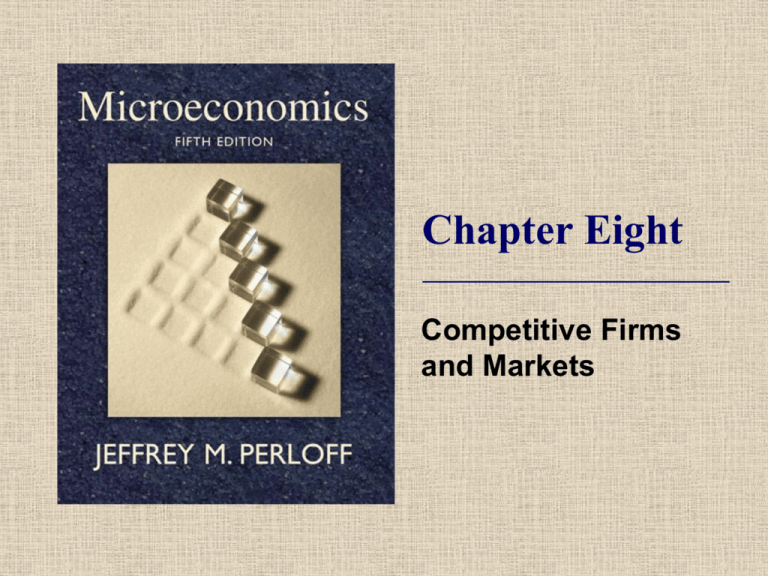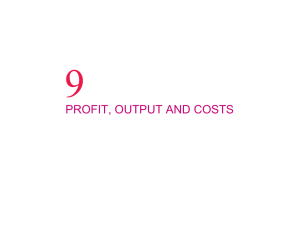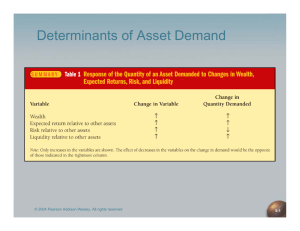
Chapter Eight
Competitive Firms
and Markets
Topics
Competition.
Profit Maximization.
Competition in the Short Run.
Competition in the Long Run.
Zero Profit for Competitive Firms in the
Long Run.
© 2009 Pearson Addison-Wesley. All rights reserved.
8-2
Price Taking
A market is competitive if each firm in
the market is a price taker.
price taker - a firm that cannot significantly
affect the market price for its output or the
prices at which it buys its inputs.
the price taker firm faces a demand curve
that is horizontal at the market price.
© 2009 Pearson Addison-Wesley. All rights reserved.
8-3
Why the Firm’s Demand Curve Is
Horizontal
Consumers believe that all firms in the
market sell identical products.
Firms freely enter and exit the market.
Buyers and sellers know the prices
charged by firms.
Transaction costs are low.
We call a market in which all these
conditions hold a perfectly competitive
market.
© 2009 Pearson Addison-Wesley. All rights reserved.
8-4
Derivation of a Competitive Firm’s
Demand Curve
residual demand curve - the market
demand that is not met by other sellers
at any given price.
D’(p) = D(p) − So(p).
© 2009 Pearson Addison-Wesley. All rights reserved.
8-5
Figure 8.1 Residual Demand Curve
© 2009 Pearson Addison-Wesley. All rights reserved.
8-6
Profit Maximization
economic profit - revenue minus
economic cost.
π = R − C.
If profit is negative, π < 0, the firm makes a
loss.
economic cost includes both explicit and
implicit costs.
© 2009 Pearson Addison-Wesley. All rights reserved.
8-7
Two Steps to Maximizing Profit
The firm’s profit function is:
π(q) = R(q) − C(q).
To maximize its profit, any firm must answer
two questions:
Output decision - If the firm produces, what
output level, q*, maximizes its profit or minimizes
its loss?
Shutdown decision - Is it more profitable to
produce q* or to shut down and produce no
output?
© 2009 Pearson Addison-Wesley. All rights reserved.
8-8
Output Rules.
Output Rule 1: The firm sets its output
where its profit is maximized.
Output Rule 2: A firm sets its output
where its marginal profit is zero.
© 2009 Pearson Addison-Wesley. All rights reserved.
8-9
MR = MC
marginal revenue (MR) - the change in
revenue a firm gets from selling one
more unit of output: MR =DR/Dq
marginal profit - the change in profit a
firm gets from selling one more unit of
output.
The change in the firm’s profit is:
Marginal profit(q) = MR(q) − MC(q).
© 2009 Pearson Addison-Wesley. All rights reserved.
8-10
MR = MC (cont).
The change in the firm’s profit is:
Marginal profit(q) = MR(q) − MC(q).
Output Rule 3: A firm sets its output
where its marginal revenue equals its
marginal cost:
MR(q) = MC(q).
© 2009 Pearson Addison-Wesley. All rights reserved.
8-11
Shutdown Rule 1
Shutdown Rule 1: The firm shuts down
only if it can reduce its loss by doing so.
Example: R = $2,000, VC = $1,000, and
F = $3,000.
This firm is making a short-run loss:
π = $2,000 − $1,000 − $3,000 = −$2,000.
But if it were to shutdown, the loss would
be:
π = −$3,000 = FC
© 2009 Pearson Addison-Wesley. All rights reserved.
8-12
Shutdown Rule 2
Shutdown Rule 2: The firm shuts down
only if its revenue is less than its
avoidable cost.
© 2009 Pearson Addison-Wesley. All rights reserved.
8-13
Short-Run Output Decision.
Because a competitive firm’s marginal
revenue equals the market price:
MR = p
a profit-maximizing competitive firm
produces the amount of output at which
its marginal cost equals the market
price:
MC(q) = p.
© 2009 Pearson Addison-Wesley. All rights reserved.
8-14
Application Breaking Even on
Christmas Trees
© 2009 Pearson Addison-Wesley. All rights reserved.
8-15
Figure 8.2 Maximizing Profit
© 2009 Pearson Addison-Wesley. All rights reserved.
8-16
Figure 8.3 How
a Competitive
Firm Maximizes
Profit
Cost, revenue, Thousand $
(a)
4,800
Which determines
the slope of the R
curve (=8)
Cost, C
Revenue
and more rapidly
with more output.
The cost curve, C, rises
less rapidly with low
output….
100
0
–100
p, $ per ton
The demand for the firm
is horizontal….
q, Thousand metric tons of lime peryear
(b)
8
p = MR
0
q, Thousand metric tons of lime peryear
© 2009 Pearson Addison-Wesley. All rights reserved.
Figure 8.3 How
a Competitive
Firm Maximizes
Profit
Cost, revenue, Thousand $
(a)
Revenue
2,272
1,846
Firm maximizes
profit by producing
q = 284 …
p*
p(q)
100
0
–100
p* = $426,000
284
q, Thousand metric tons of lime peryear
(b)
p, $ per ton
Which also the point
at which MC = p …
Cost, C
4,800
MC
8
0
© 2009 Pearson Addison-Wesley. All rights reserved.
e
284
p = MR
q, Thousand metric tons of lime peryear
Figure 8.3 How
a Competitive
Firm Maximizes
Profit
Cost, revenue, Thousand $
(a)
Cost, C
4,800
Revenue
2,272
p*
1,846
840
p(q)
426
100
0
–100
p* = $426,000
140
284
q, Thousand metric tons of lime peryear
p, $ per ton
(b)
10
MC
AC
e
8
p = MR
p* = $426,000
6.50
6
0
© 2009 Pearson Addison-Wesley. All rights reserved.
140
284
q, Thousand metric tons of lime peryear
Figure 8.3 How
a Competitive
Firm Maximizes
Profit
Cost, revenue, Thousand $
(a)
Cost, C
4,800
Revenue
2,272
p*
1,846
840
p(q)
426
100
0
–100
p* = $426,000
140
284
q, Thousand metric tons of lime peryear
p, $ per ton
(b)
What if the market
price fell below $6?
10
MC
AC
e
8
p = MR
p* = $426,000
6.50
6
0
© 2009 Pearson Addison-Wesley. All rights reserved.
140
284
q, Thousand metric tons of lime peryear
Solved Problem 8.1
If a specific tax of τ is collected from only
one competitive firm, how should that
firm change its output level to maximize
its profit, and how does its maximum
profit change?
© 2009 Pearson Addison-Wesley. All rights reserved.
8-21
Solved Problem 8.1
© 2009 Pearson Addison-Wesley. All rights reserved.
8-22
Short-Run Shutdown Decision.
The firm can gain by shutting down only if its
revenue is less than its short-run variable
cost:
pq < VC
In average terms:
p < AVC(q).
A competitive firm shuts down if the market price
is less than the minimum of its short-run
average variable cost curve.
© 2009 Pearson Addison-Wesley. All rights reserved.
8-23
The Short-Run Shutdown Decision
© 2009 Pearson Addison-Wesley. All rights reserved.
8-24
Solved Problem 8.2
A competitive firm’s bookkeeper, upon
reviewing the firm’s books, finds that the
firm spent twice as much on its plant, a
fixed cost, as the firm’s manager had
previously thought. Should the manager
change the output level because of this
new information? How does this new
information affect profit?
© 2009 Pearson Addison-Wesley. All rights reserved.
8-25
Short-Run Firm Supply Curve
If the price falls below the firm’s
minimum average variable cost the firm
shuts down.
Thus:
the competitive firm’s short-run supply curve
is its marginal cost curve above its
minimum average variable cost.
© 2009 Pearson Addison-Wesley. All rights reserved.
8-26
Figure 8.5 How the Profit-Maximizing
Quantity Varies with Price
© 2009 Pearson Addison-Wesley. All rights reserved.
8-27
Factor Prices and the Short-Run Firm
Supply Curve
An increase in factor prices causes the
production costs of a firm to rise, shifting
the firm’s supply curve to the left.
© 2009 Pearson Addison-Wesley. All rights reserved.
8-28
Figure 8.6 Effect of an Increase in the Cost of
Materials on the Vegetable Oil Supply Curve
© 2009 Pearson Addison-Wesley. All rights reserved.
8-29
Short-Run Market Supply Curve
In the short run, the maximum number
of firms in a market, n, is fixed.
If all the firms in a competitive market
are identical, each firm’s supply curve is
identical, so the market supply at any
price is n times the supply of an
individual firm.
© 2009 Pearson Addison-Wesley. All rights reserved.
8-30
Short-Run Market Supply with Identical
Firms.
As the number of firms grows very large,
the market supply curve approaches a
horizontal line at the minimum point of
the AVC curve.
Thus,
the more identical firms producing at a
given price, the flatter (more elastic) the
short-run market supply curve at that
price
© 2009 Pearson Addison-Wesley. All rights reserved.
8-31
Figure 8.7 Short-Run Market Supply
with Five Identical Lime Firms
© 2009 Pearson Addison-Wesley. All rights reserved.
8-32
Figure 8.8 Short-Run Market Supply
with Two Different Lime Firms
© 2009 Pearson Addison-Wesley. All rights reserved.
8-33
Figure 8.9 Short-Run Competitive
Equilibrium in the Lime Market
(b) Market
8
p, $ per ton
p, $ per ton
(a) Firm
S1
e1
7
6.97
A
S
8
D1
7
E1
AC
B
D2
6.20
AVC
C
5
0
5
e2
q2 = 50
q1 = 215
q, Thousand metric tons
of lime per year
© 2009 Pearson Addison-Wesley. All rights reserved.
0
E2
Q2 = 250
Q1 = 1,075
Q, Thousand metric tons
of lime per year
8-34
Solved Problem 8.3
What is the effect on the short-run
equilibrium of a specific tax of τ per unit
that is collected from all n firms in a
market? What is the incidence of the
tax?
© 2009 Pearson Addison-Wesley. All rights reserved.
8-35
Solved Problem 8.3
© 2009 Pearson Addison-Wesley. All rights reserved.
8-36
Long-Run Output Decision.
The firm chooses the quantity that
maximizes its profit using the same rules
as in the short run.
The firm picks the quantity that maximizes
long-run profit, the difference between
revenue and long-run cost.
© 2009 Pearson Addison-Wesley. All rights reserved.
8-37
Long-Run Shutdown Decision.
In the long run, the firm shuts down if it
would make an economic loss by
operating.
© 2009 Pearson Addison-Wesley. All rights reserved.
8-38
Long-Run Firm Supply Curve
A firm’s long-run supply curve is its longrun marginal cost curve above the
minimum of its long-run average cost
curve.
The firm is free to choose its capital in the
long run, so the firm’s long-run supply curve
may differ substantially from its short-run
supply curve.
© 2009 Pearson Addison-Wesley. All rights reserved.
8-39
Figure 8.10 The Short-Run and LongRun Supply Curves
© 2009 Pearson Addison-Wesley. All rights reserved.
8-40
Long-Run Market Supply Curve
The competitive market supply curve is
the horizontal sum of the supply curves
of the individual firms in both the short
run and the long run.
But, in the long run, firms can enter or leave
the market.
Thus, before we can obtain the long-run market
supply curve, we need to determine how many
firms are in the market at each possible market
price.
© 2009 Pearson Addison-Wesley. All rights reserved.
8-41
Role of Entry and Exit.
In a market with free entry and exit:
A firm enters the market if it can make a
long-run profit, π > 0.
A firm exits the market to avoid a long-run
loss, π < 0.
If firms in a market are making zero longrun profit, they stay in the market.
© 2009 Pearson Addison-Wesley. All rights reserved.
8-42
Table 8.1 Average Annual Entry and Exit Rates
in Selected U.S. Industries, 1989–1996
© 2009 Pearson Addison-Wesley. All rights reserved.
8-43
Long-Run Market Supply with Identical
Firms and Free Entry.
The long-run market supply curve is flat
at the minimum long-run average cost if
firms can freely enter and exit the
market, an unlimited number of firms
have identical costs, and input prices
are constant.
© 2009 Pearson Addison-Wesley. All rights reserved.
8-44
Long-Run Market Supply When Entry Is
Limited.
If the number of firms in a market is
limited in the long run, the market supply
curve slopes upward.
© 2009 Pearson Addison-Wesley. All rights reserved.
8-45
Figure 8.11 Long-Run Firm and Market
Supply with Identical Vegetable Oil Firms
© 2009 Pearson Addison-Wesley. All rights reserved.
8-46
Long-Run Market Supply When Firms
Differ.
Firms with relatively low minimum longrun average costs are willing to enter the
market at lower prices than others,
resulting in an upward-sloping long-run
market supply curve.
© 2009 Pearson Addison-Wesley. All rights reserved.
8-47
Application Upward-Sloping Long-Run
Supply Curve for Cotton
© 2009 Pearson Addison-Wesley. All rights reserved.
8-48
Long-Run Market Supply When Input
Prices Vary with Output.
A third reason why market supply curves
may slope is nonconstant input prices.
In markets in which factor prices rise or fall
when output increases, the long-run supply
curve slopes even if firms have identical
costs and can freely enter and exit.
© 2009 Pearson Addison-Wesley. All rights reserved.
8-49
Increasing and Constant-Cost Markets.
increasing-cost market - a market in
which input prices rise with output.
constant-cost market – a market in
which input prices remain constant as
output increases.
the long-run supply curve is upward
sloping in an increasing-cost market and
flat in a constant-cost market.
© 2009 Pearson Addison-Wesley. All rights reserved.
8-50
Figure 8.12 Long-Run Market Supply
in an Increasing-Cost Market
© 2009 Pearson Addison-Wesley. All rights reserved.
8-51
Decreasing-cost markets
decreasing-cost markets - a market in
which as market output rises, at least
some factor prices fall.
As a result,
in a decreasing-cost market, the long-run
market supply curve is downward sloping.
© 2009 Pearson Addison-Wesley. All rights reserved.
8-52
Figure 8.13 Long-Run Market Supply
in a Decreasing-Cost Market
© 2009 Pearson Addison-Wesley. All rights reserved.
8-53
Long-Run Market Supply Curve with
Trade.
residual supply curve - the quantity
that the market supplies that is not
consumed by other demanders at any
given price:
S’(p) = S(p) − Do(p).
© 2009 Pearson Addison-Wesley. All rights reserved.
8-54
Figure 8.14 Excess or Residual Supply
Curve
© 2009 Pearson Addison-Wesley. All rights reserved.
8-55
Solved Problem 8.4
In the short run, what happens to the
competitive market price of gasoline if
the demand curve in a state shifts to the
right as more people move to the state
or start driving gashogging SUVs? In
your answer, distinguish between areas
in which regular gasoline is sold and
jurisdictions that require special blends.
© 2009 Pearson Addison-Wesley. All rights reserved.
8-56
Solved Problem 8.4
© 2009 Pearson Addison-Wesley. All rights reserved.
8-57
Figure 8.15 The Short-Run and LongRun Equilibria for Vegetable Oil
© 2009 Pearson Addison-Wesley. All rights reserved.
8-58
Solved Problem 8.5
If the government starts collecting a
lump-sum franchise tax of each year
from each identical firm in a competitive
market with free entry and exit, how do
the long-run market and firm equilibria
change?
© 2009 Pearson Addison-Wesley. All rights reserved.
8-59
Solved Problem 8.5
© 2009 Pearson Addison-Wesley. All rights reserved.
8-60
Zero Long-Run Profit with Free Entry
One implication of the shutdown rule is
that the firm is willing to operate in the
long run even if it is making zero profit.
But how can this be?
Because opportunity cost includes the
value of the next best investment, at a zero
long-run economic profit, the firm is earning
the normal business profit that the firm
could earn by investing elsewhere in the
economy.
© 2009 Pearson Addison-Wesley. All rights reserved.
8-61
Zero Long-Run Profit When Entry Is
Limited
Rent - a payment to the owner of an
input beyond the minimum necessary for
the factor to be supplied
© 2009 Pearson Addison-Wesley. All rights reserved.
8-62
Figure 8.16 Rent
© 2009 Pearson Addison-Wesley. All rights reserved.
8-63






